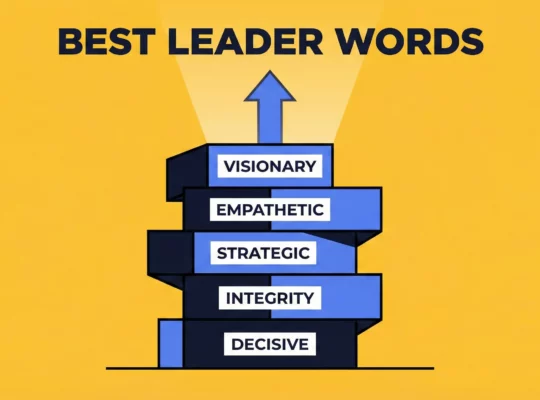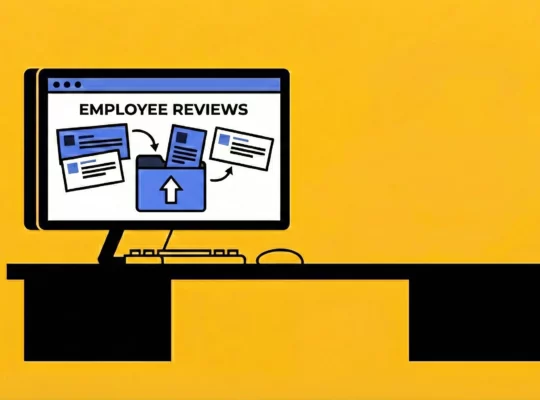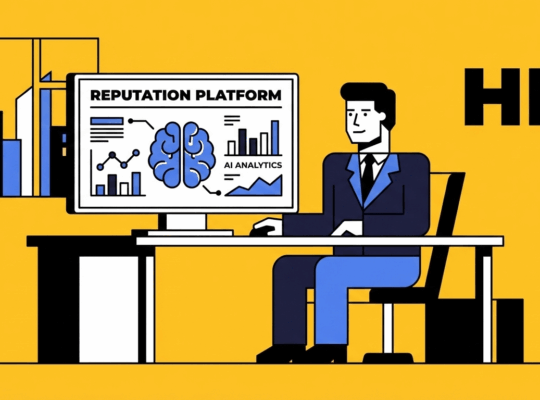Modern human resources (HR) demands strategic tools, among which, employee review software plays a pivotal role. The primary purpose of this specialized software is to streamline and enhance performance management processes, leading to more effective employee development and overall organizational success. For HR managers, effective performance management is not just a cyclical task, but a crucial element in cultivating a thriving and productive workforce. This article is tailored for HR professionals like you, offering a comprehensive guide to understanding, selecting, and implementing employee evaluation software that meets your unique organizational needs. By leveraging the right software you can boost efficiency, ensure fair and objective evaluations, and drive employee development leading to improved employee engagement.
Why Implement Employee Review Software?
Making the leap to implement performance management software can be a big decision for HR. The advantages it brings to HR professionals, though, can be incredibly rewarding.
Increased Efficiency & Automation
For HR departments often burdened with administrative tasks, employee review software provides significant relief.
- The software can automate aspects of review cycles, significantly reducing the time spent on manual processes.
- The tool helps to streamline the review process from beginning to end.
- These programs create automated workflows for reviews, approvals, and notifications.
Data-Driven Decision Making
Moving beyond subjective feelings, performance tracking can provide actionable insights.
- The software must monitor employee performance over time with robust performance tracking and analytics.
- HR can utilize performance data to identify top performers and potential areas for skills uplift.
- This software is capable of generating comprehensive reporting of employee performance, development, and engagement.
- Employing quantifiable measures enables fair and comprehensive analyses of performance reviews.
Fairness & Objectivity in Evaluations
Fairness is paramount in performance evaluations, and employee performance software enhances objectivity.
- Structured processes help diminish prejudice in performance evaluations.
- Data-driven insights ensure equitable decisions.
- The software supports calibration sessions to facilitate consistent ratings across teams through calibration.
Enhanced Employee Development & Engagement
Investing in employee development translates to an increase in employee morale. Skill development is also something important to consider.
- Effective software helps foster clear communication between managers and employees regarding performance and expectations.
- These systems identify areas where employees can benefit from training.
- Review tools encourage a culture of continuous feedback, improving engagement.
- These systems should integrate development plans directly into the review process.
- The best software can also track goals and objectives directly through goal setting.
Improved Succession Planning
Succession planning is crucial for long-term organizational health. By recognizing possible future leaders, the organization makes sure it will exist for years to come.
- The plans track employee growth and indicate high-potential employees for future leadership roles.
- Through competency assessments, the software evaluates employee readiness for advancement in performance metrics.
Essential Features to Look for in Employee Review Software
Choosing the right performance review software requires careful consideration of key features.
360-Degree Feedback & Peer Reviews
Holistic feedback mechanisms are vital for a comprehensive understanding of employee performance. 360 feedback can be a powerful tool.
- The software enables feedback from peers, managers, and self-assessments for a multifaceted view of performance.
- Employees also can provide feedback about the review process.
Goal Setting & Tracking
Linking goals to performance creates a clear line of sight for employees. Goals are paramount to the success of any organization.
- Users can set clear goals and track progress toward objectives.
- The best employee review software integrates goals into performance reviews for alignment and accountability.
Performance Tracking & Analytics
Robust analytics capabilities provide valuable insights for decision-making.
- The software should monitor key performance metrics and identify trends.
- Users should be able to generate reports on individual, team, and company-wide performance to assess if they are being successful.
Templates & Customization
Flexibility is key to adapting the software to your organization’s unique needs. Templates offer a starting point for organizations.
- The software offers pre-built templates for different types of reviews and roles.
- Users can customize the review process to align with the organization’s specific needs.
Integration with HR Systems
Seamless integration streamlines data management and reduces manual effort.
- These tools easily integrate with other HR systems such as payroll, HRIS, and applicant tracking systems (ATS).
- Several solutions integrate with other HR systems, like payroll and Microsoft Office 365 and integrate seamlessly.
Mobile Accessibility
Accessibility must be a consideration for everyone as it increases convenience.
- The product offers a convenient mobile experience so that employees and managers can access reviews and feedback while traveling.
- Review systems can offer a convenient mobile experience.
Ease of Use
User-friendliness encourages adoption and maximizes the software’s impact. Without the capacity to easily use the system, little will be gained from new software!
- The best platforms should allow employee feedback and be easy to use across the company.
Implementing Employee Review Software: A Step-by-Step Guide for HR Professionals
Implementing employee review software requires a strategic approach. Careful planning is important for implementation.
Define Your Needs & Objectives
Start by identifying your organization’s unique needs and goals.
- Define the specific goals you want to achieve with employee review software.
- Pinpoint the essential features and functionalities that you require.
Research & Evaluate Software Options
Compare different platforms and their features.
- Evaluate different software platforms and their features to see what is available.
- Consider reading reviews and testimonials from other HR professionals. Take other users into account.
- Request demos or trials to test the software before committing to a purchase. This is the best way to see if it works.
- It’s important to select the software that best suits an organization’s needs.
Pilot Program & Training
Test the software with a small group of employees before full rollout.
- Undertake a pilot program with a small group of employees to test the software and gain feedback of real-world value.
- Provide comprehensive training to managers and employees on how to use the software effectively.
Rollout & Communication
Clearly communicate the benefits of the new software to all employees.
- Talk about the benefits of the new software to all employees.
- Provide ongoing support and resources. This can demonstrate the value.
Monitor & Evaluate
Track key metrics to measure the success of the software implementation.
- Follow key performance metrics to measure the success of the software implementation.
- When possible, gather feedback from employees and managers to identify areas for improvement.
Best Practices for Using Employee Review Software Effectively
To maximize the impact of performance appraisal software, adhere to these best practices.
Set Clear Expectations
Communicate clear goals and expectations to employees. Providing clarity is essential.
- Communicate clear goals and performance expectations to employees.
Provide Regular Feedback
Encourage managers to provide regular feedback to employees.
- Encourage managers to give frequent and constructive feedback to employees, both positive and negative.
Focus on Development
Use reviews as an opportunity to identify development needs.
- Performance reviews should be used as an opportunity for development and to create development plans. This can lead to performance improvement.
Ensure Fairness and Consistency
Maintain consistency in ratings and processes. Consistency is key to fairness.
- Calibrate ratings and train managers on how to conduct fair and objective reviews.
Incorporate Employee Input
Solicit feedback on the review process and the software itself.
- Actively encourage employees to provide feedback on the review process and the software.
Maintain Confidentiality
Protect employee performance data. Security is paramount.
- Ensure that employee performance data is kept confidential and secure.
The Future of Employee Review Software
The future of continuous performance management is evolving rapidly.
AI-Powered Performance Management
Artificial intelligence (AI) is beginning to transform performance management.
- Artificial intelligence could play a role in many areas of performance management and the functions of employee review.
Personalized Development
Personalized experiences are becoming increasingly common across various functions.
- A world that uses experiences personalized for each team member for employee performance.
Frequently Asked Questions
What is employee review software and why is it important?
Employee review software automates and streamlines the process of performance reviews, providing a centralized platform for feedback, goal setting, and performance tracking. It’s essential because it improves efficiency, ensures fairness, facilitates employee development, and provides data-driven insights for better decision-making.
Who benefits from using employee review software?
HR departments, managers, and employees all benefit. HR gains efficiency and data insights, managers can provide more effective feedback and track team performance, and employees receive regular feedback, understand expectations, and have opportunities for development.
When should an organization implement employee review software?
An organization should consider implementing it when manual review processes become too time-consuming, when there is a need for more objective evaluations, or when the organization wants to improve employee engagement and development. A growing organization may need to use it.
Where can employee review software be used?
The software can be used across various departments and locations within an organization. Cloud-based solutions enable access from anywhere, supporting remote work and global teams.
Why choose employee review software over manual processes?
Employee review software offers increased efficiency, reduced bias, data-driven insights, and better employee engagement compared to manual processes. It automates tasks, provides standardized frameworks, and ensures consistent and fair evaluations. It can also provide significant time savings.
How does employee review software improve employee performance?
It improves employee performance by providing regular feedback, clear goal setting, and opportunities for development. Performance tracking features allow employees and managers to monitor progress and identify areas for improvement, leading to better employee performance.
Conclusion
Employee review software can greatly improve how you manage your teams, provide transparency through reviews and reports that help with strategy. As you consider integrating this software into your HR infrastructure, remember to prioritize features that promote data accuracy, employee involvement, and streamlined workflows. By strategically selecting and implementing the right solution, the organization can build a workforce that is engaged, high-performing, and strategically aligned for future growth. Explore the possibilities today with Review.jobs and start shaping a brighter future for your organization.





